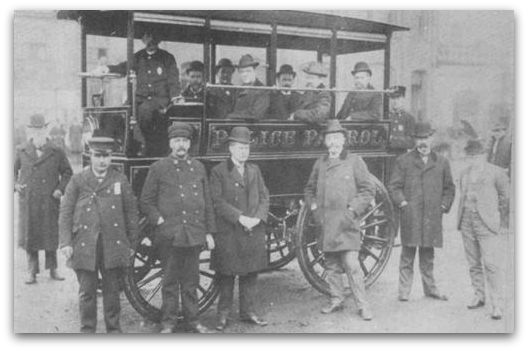Bathroom Readers' Institute's Blog, page 105
August 5, 2015
6 Weird August Holidays You Ought to Celebrate
It’s common knowledge that August is the only month without any “real holidays.” But this list of observances prove…that common knowledge is often correct.
 August 6: Wiggle Your Toes Day
August 6: Wiggle Your Toes DayThis is the day to free your feet from the confines of shoes and let those little piggies out for the world to see. (Provided you’ve cleaned them and cut the nails, of course.
August 7: National Lighthouse Day
Did you car trips as a kid consist of driving up and down the coast while your parents visited boring lighthouse after boring lighthouse? Well, those lighthouses were once a very important lifesaving technology when the world had a more maritime economy. On August 7, 1789, Congress federalized the building and operation of lighthouses and this holiday commemorates all the lives not lost at sea.
August 9: Book Lovers Day
Now here’s one that Uncle John can get behind.
August 11: Presidential Joke Day
It’s not so much a day for jokes about presidents, so much as it is a day to commemorate when a U.S. president made a very famous joke. On August 11, 1984, President Ronald Reagan was preparing for his weekly radio address with what he thought was a sound check. He didn’t realize he was actually broadcasting live when he quipped, “My fellow Americans, I am pleased to tell you I just signed legislation which outlaws Russia forever. The bombing begins in five minutes.”
August 16: National Tell a Joke Day
Everyday is National Tell a Joke Day when you work at the Bathroom Readers’ Institute (or if you’re Ronald Reagan), but this is the day you absolutely must tell a joke. Here’s an old favorite: A man places a frozen single-serving pizza and a single can of soda on the conveyor belt at a grocery store checkout. “Single, huh?” the cashier asks the man. “How did you know?” the man responds. “Oh, it’s because you’re so ugly.”
August 30: Frankenstein Day
August 30, 1797 is the birthday of author Mary Wollenstonecraft Shelley, who wrote Frankenstein in 1818, when she was just 21 years old. Today’s a great day to read Shelley’s genre-creating novel, watch one of the many Frankenstein movies, or just rock out to this:
The post 6 Weird August Holidays You Ought to Celebrate appeared first on Trivia Books and Facts | Uncle John's Bathroom Reader.
August 4, 2015
The Great Otter Pop Protest of ‘96
The story of how a group of kids banded together to save their favorite, uh, freezer pop.
Outselling competitors like Pop-Ice and Fla-Vor-Ice, Otter Pops are the most popular brand of freezer pops: clear plastic tubes filled with colored liquid that turn into a Popsicle-like treat for kids when frozen. Otter Pops stand out because they don’t just have flavor names, but an anthropomorphic character representing them, like Little Orphan Orange, Strawberry Short Kook, and Sir Isaac Lime. Since its launch by National Pax Corp. in 1968, the lineup of flavors and characters had changed just once, when Rip Van Lemon was dropped in favor of Ponco Punch. In 1996, the company announced that it was replacing Sir Isaac Lime, which market research showed was its least popular flavor, with Scarlett O’Cherry, a flavor it had spent a year and more than $100,000 developing.
 Big deal, a new freezer pop flavor replacing an unpopular one. It was a big deal, to Costa Mesa, California nine-year-old Kevin Kee. He had gotten hooked on Otter Pops as a baby, teething on them, which grew into a three-a-day habit by the time he was in elementary school. Kevin heard about the Sir Isaac Lime switchout on an Otter Pops website for fans, and was livid. He wanted to tell National Pax not that he was unhappy, but that they shouldn’t be that willing to change a beloved product.
Big deal, a new freezer pop flavor replacing an unpopular one. It was a big deal, to Costa Mesa, California nine-year-old Kevin Kee. He had gotten hooked on Otter Pops as a baby, teething on them, which grew into a three-a-day habit by the time he was in elementary school. Kevin heard about the Sir Isaac Lime switchout on an Otter Pops website for fans, and was livid. He wanted to tell National Pax not that he was unhappy, but that they shouldn’t be that willing to change a beloved product.
Wanting to help her son, Kevin’s mother Amy Kee Cordova thought back to an episode of The Brady Bunch, where the six sitcom kids successfully lobbied their town’s government to cancel plans to turn a park into a parking lot. As she told a reporter for the Los Angeles Times, Cordova told Kevin to “always stand up for what you believe in.”
With the help of three younger cousins, Kevin collected signatures at his elementary school on a “Save Isaac Lime” petition, which he planned to present in person at National Pax headquarters in Riverside, California. (Kevin and his cousins also made up a bunch of protests signs adorned with slogans like “Scarlett O’Cherry is Unnecessary.”)
News of the death of Sir Isaac Lime spread via the Otter Pops fan website, and by the time Kevin, his mother, and 12 other kids picketed National Pax headquarters, they had 130 signatures…and company CEO Ron Cedillos had dozens of angry letters. A Stanford professor and Otter Pops fan accused the company of “otter-cide.”
Cedillos invited Kevin and his friends inside and defended the end of Sir Issac Lime, explaining market research and development costs. But Kevin must have said something persuasive, or he kept saying it, because by the end of the protest, he’d been given 1,000 free Otter Pops, a 3-foot-tall inflatable Sir Isaac Lime toy…and Cedillos word that Scarlett O’Cherry would not be replacing Isaac. He kept his word—Sir Isaac Lime is still available in packages of Otter Pops.
The post The Great Otter Pop Protest of ‘96 appeared first on Trivia Books and Facts | Uncle John's Bathroom Reader.
July 30, 2015
The Tragic Fencing Death of Vladimir Smirnov
If it seems like a sport that’s just two people sticking swords at each other could result in death…it absolutely could. And did.
By 1980, Vladimir Smirnov was one of the best fencers in the world, if not the best. In a sport in which the Soviet Union was always very competitive, the Ukrainian born athlete won three medals in three separate events at the 1980 Summer Olympics, held in Moscow (the ones the U.S. boycotted). Smirnov won a bronze medal for the Men’s team épée, a silver in the foil team, and the gold for the foil individual. (The “foil” and épée are two different types of swords; the foil is light and flexible, and the épée is heavier and with a thicker blade.)
 Smirnov continued to dominate world fencing, winning the World Championship in 1981. He returned to defend his title in the 1982 championships in Rome. Smirnov faced off in an early round against 1976 Olympic gold medalist Matthias Behr of West Germany. While fencing is generally quite safe—competitors wear chest protectors, vests, gloves, and face masks, among other equipment—this match resulted in a tragic, fluke accident. As the two world-class fencers squared off and jabbed at each other, Behr lunged at Smirnov…and his sword broke. Improbably, the broken, jagged, and thin blade penetrated the mesh of Smirnov’s face mask, and kept going. It punctured Smirnov’s eye socket, and the blade went into his brain.
Smirnov continued to dominate world fencing, winning the World Championship in 1981. He returned to defend his title in the 1982 championships in Rome. Smirnov faced off in an early round against 1976 Olympic gold medalist Matthias Behr of West Germany. While fencing is generally quite safe—competitors wear chest protectors, vests, gloves, and face masks, among other equipment—this match resulted in a tragic, fluke accident. As the two world-class fencers squared off and jabbed at each other, Behr lunged at Smirnov…and his sword broke. Improbably, the broken, jagged, and thin blade penetrated the mesh of Smirnov’s face mask, and kept going. It punctured Smirnov’s eye socket, and the blade went into his brain.
The match was immediately called off as Smirnov fell in pain. He died nine days later, one of the only seven fencers to die as a result of injuries sustained in competition. The death naturally led to sweeping changes in fencing, and fencing gear safety. Carbon steel blades like the one used by Behr and Smirnov were replaced with maraging steel blades, which are much tougher and far less likely to break upon impact. Further, fencers now are more likely to wear Kevlar or strong nylon uniforms, as well as masks made with stronger steel alloys. Since the 1982 accident, there have been no deaths in high-level fencing.
The post The Tragic Fencing Death of Vladimir Smirnov appeared first on Trivia Books and Facts | Uncle John's Bathroom Reader.
Car Talk: Automobile Records and Firsts
Officer Louis Mueller Sr. operated the first police car in Akron, Ohio, in 1899, when he was assigned to pick up an intoxicated man. Run by electricity, the vehicle could reach a speed of only 16 miles per hour and travel 30 miles before needing to recharge its battery. The car cost $2,400 and was equipped with electric lights, a stretcher, and gongs for a siren.
 First Land-Speed Record
First Land-Speed RecordFrench race-car driver Count Gaston de Chasseloup-Laubat (better known as the “Electric Count”) set the world’s first land-speed record when he raced his electric car down a deserted road near Paris, France, in 1898…at the “incredible” speed of 39.24 mph. The count was not satisfied with his feat, though, so tried again in January 1899, screeching down the road and breaking his own record with a new speed of 43.64 mph.
First Solar-Powered Car
When William G. Cobb of General Motors showcased the first solar car at the Chicago Powerama convention in 1955, there was one small problem—at only 15 inches, it was too small to drive. Seventeen years later, the International Rectifier Company unveiled something a little more realistic: a 1912 Baker electric car converted to run on solar power.
 First Gas Pump
First Gas PumpOn September 5, 1885, Sylvanus Bowser of Fort Wayne, Indiana, delivered the first gasoline pump to a local gas station. Bowser had manufactured a pump tank that held one barrel of gasoline. Thirteen years later, pumps were manufactured that could draw fuel from an underground tank.
First Sanctioned Drag Race
On April 10, 1949, California street racers and hot-rodders gathered in the town of Goleta, north of Santa Barbara. Their race would take place on an airstrip that the military used to train pilots. Complete with a flagman at the starting line and another at the finish a quarter-mile away, the fastest local roadsters showed up to race each other sideby- side. Thousands of spectators also came and watched the 10- second race.
 First published in Uncle John’s Bathroom Reader History’s Lists.
First published in Uncle John’s Bathroom Reader History’s Lists.
The post Car Talk: Automobile Records and Firsts appeared first on Trivia Books and Facts | Uncle John's Bathroom Reader.
July 29, 2015
The Tale of Polybius, the Deadly Arcade Game That Probably Doesn’t Exist
One of video gaming’s craziest and earliest urban legends.
When video games became mainstream in the 1980s, they sparked lots of mass hysteria, with parents claiming that games did everything from make their kids violent to make them into lazy slobs with carpal tunnel syndrome. And then there was Polybius, an arcade game that supposedly hypnotized gamers and broke their brains.
 Like any urban legend, this one was spread by word of mouth and it’s difficult to pinpoint where or when it got started. But if the story is to be believed, Polybius was a mysterious game produced by a company called Sinneslöschen that began popping up in suburban Portland arcades in 1981. It was supposedly very addictive, and within a few days, gamers began showing up in droves to play it. Fistfights even broke out in some arcades when people wouldn’t stop hogging the machines.
Like any urban legend, this one was spread by word of mouth and it’s difficult to pinpoint where or when it got started. But if the story is to be believed, Polybius was a mysterious game produced by a company called Sinneslöschen that began popping up in suburban Portland arcades in 1981. It was supposedly very addictive, and within a few days, gamers began showing up in droves to play it. Fistfights even broke out in some arcades when people wouldn’t stop hogging the machines.
Polybius was so addictive because it was allegedly part of a government plot to test the psychoactive effects of video games on the public. The game’s flashing lights and subliminal messages could supposedly hypnotize and even brainwash gamers. Those who got hooked, the story goes, developed negative health problems ranging from insomnia to amnesia to extreme anxiety. Others claim that Polybius drove people completely insane and that government goons snuck into arcades at night to collect data and tweak the settings on each machine. (Also, sinneslöschen means “sensory deprivation” in German.)
Of course, all of this is complete hogwash. The game’s name itself is a reference to a writer from Ancient Greece who once argued that historians should never publish stories they can’t verify. There have been several attempts to debunk the rumors surrounding Polybius over the years. According to one, the legend was probably inspired by a 1981 incident in Portland when two players fell ill after playing Asteroids for 28 hours straight. Around that same time, an early version of Tempest caused some to get motion sickness and vertigo.
References to the legend have popped up everywhere from comic books to TV shows. A 2006 episode of The Simpsons featured Bart visiting an arcade filled with outdated games. He passes by a Polybius machine stamped with the words “Property of U.S. Government.” In 2013, a “homebrew” version of the game for the Atari 2600, produced by designer Chris Trimiew, debuted at the Portland Retro Gaming Expo. A group of filmmakers are also currently in the process of trying to make a documentary about the legend called The Polybius Conspiracy.
https://d2pq0u4uni88oo.cloudfront.net/projects/1821307/video-537039-h264_high.mp4
The post The Tale of Polybius, the Deadly Arcade Game That Probably Doesn’t Exist appeared first on Trivia Books and Facts | Uncle John's Bathroom Reader.
7 Fun Facts About American Currency
These fun facts are money in your pocket!
Coins can last in circulation for as long as 25 years, but paper money disintegrates faster. According to the Bureau of Engraving and Printing, a $1 bill lasts for 22 months in circulation, the $5 lasts 16 months, a $10 goes two years, a $50 makes it to 55 months, and a $100 can go for 89 months.
Just under half of all money in circulation are $1 bills.
Susan B. Anthony and Sacajawea have appeared on coins. A woman will soon appear on the $10 bill, but it won’t be the first time a woman has been depicted on paper money. In 1886, first First Lady Martha Washington was depicted on the $1 Silver Certificate, issued in 1886 and 1891.
The largest bill ever created wasn’t really a piece of money anyone could use. In 1934, the government created a handful of gold-colored $100,000 bills. They were used for large transactions between Federal Reserve branches, and pictured President Woodrow Wilson.
Paper money isn’t really paper, at least not paper made from wood products. It’s 75 percent cotton, 25 percent linen, and a trace amount of silk.
$2 bills aren’t rare—the government has printed millions of them. But many people perceive that they’re rare, so they keep them at home and out of circulation, creating a false scarcity. One person who loves them: Apple co-founder Steve Wozniak. He reportedly buys $2 bills in uncut sheets from the government, and binds them into a tear-off booklet, like a checkbook but with real money.
Coins were the main form of currency until 1862, when the government issued paper bills because too many people were hoarding gold and silver. The first denominations: 1 cent, 5 cents, 25 cents, and 50 cents.
The post 7 Fun Facts About American Currency appeared first on Trivia Books and Facts | Uncle John's Bathroom Reader.
July 28, 2015
6 Quick Facts About NFL’s First Female Coach: Jen Welter
Welter just made history: She’s the NFL’s first female coach. Here are some quick facts about her.
 This week, the Arizona Cardinals appointed Jen Welter a coaching intern at its offseason training camp, where she will coach inside linebackers. This makes her the first woman to hold a coaching position of any kind in the NFL.
This week, the Arizona Cardinals appointed Jen Welter a coaching intern at its offseason training camp, where she will coach inside linebackers. This makes her the first woman to hold a coaching position of any kind in the NFL.Most NFL coaches have some prior experience playing football. Welter is no exception. There are several small, semiprofessional women’s football leagues in the United States. Welter played for the Dallas Diamonds of the Women’s Football Alliance, and for the Texas Revolution of the Indoor Football League. (Her position: running back.) All things considered, Welter has amassed 14 years of on-field football experience.
Welter also played for the Dallas Dragons of the USA Rugby League, making her one of the few people to ever play more than one sport professionally (such as Bo Jackson and Deion Sanders), and one of even fewer to jump from rugby to football.
Welter is the first female coach in NFL history, but who’s the first woman to coach in a men’s professional football league overall? Also Welter. In February, Welter was appointed the linebackers and special teams coach of the Texas Revolution.
She’s a gold medalist. The International Federation of American Football, an organization aiming to spread the popularity of American-style football overseas, holds a world championship every four years. She’s been part of the gold-medal winning Team USA twice.
She’s more educated than most other NFL coaches. Welter holds a Master’s degree in sports psychology, and a doctorate in psychology.
The post 6 Quick Facts About NFL’s First Female Coach: Jen Welter appeared first on Trivia Books and Facts | Uncle John's Bathroom Reader.
July 24, 2015
3 Places With Bad Insect Problems
Looking to book a vacation? You may want to think twice about visiting these locales during certain times of the year.
Orlando in April and October
 Orlando is the place to head if you like theme parks but its humid, subtropical climate makes it a great fit for all sorts of crazy wildlife. While it’s possible to encounter the occasional armadillo while strolling around Disney World, you may also run into lots of love bugs. Not Herbie, but Plecia nearctica, a breed of very frisky insect. These bugs mate twice a year in the spring and autumn. Countless swarms of them can be spotted living up to their nicknames in Orlando’s various resorts and theme parks. Many baffled visitors have mistaken them for two headed insects since they’re often “joined together” in flight. Whether or not they’ll annoy you during your next trip depends on how much rainfall the area has received. In years when Orlando gets lots of wet weather, the love bugs’ population booms and they can found everywhere from swimming pools to the queue outside Space Mountain. Oh, and a word of warning: they’re attracted to bright clothing.
Orlando is the place to head if you like theme parks but its humid, subtropical climate makes it a great fit for all sorts of crazy wildlife. While it’s possible to encounter the occasional armadillo while strolling around Disney World, you may also run into lots of love bugs. Not Herbie, but Plecia nearctica, a breed of very frisky insect. These bugs mate twice a year in the spring and autumn. Countless swarms of them can be spotted living up to their nicknames in Orlando’s various resorts and theme parks. Many baffled visitors have mistaken them for two headed insects since they’re often “joined together” in flight. Whether or not they’ll annoy you during your next trip depends on how much rainfall the area has received. In years when Orlando gets lots of wet weather, the love bugs’ population booms and they can found everywhere from swimming pools to the queue outside Space Mountain. Oh, and a word of warning: they’re attracted to bright clothing.
Berlin in August
The German capital has an electrifying arts scene and scores of museums, but late summer is not the time to visit. That’s when Berlin’s wasp problem gets out of hand. Most of Berlin’s cafes and businesses don’t have air conditioning so they leave their doors and windows open whenever the weather is hot. That means they’re magnets for wasps. City and government officials have made several attempts to combat the bugs but it’s a difficult problem to solve.
Scotland in July
Mid-summer might not be the best time to head to the Highlands. Rural areas especially are a haven for midges (which the locals pronounce “‘mi-jee’). These tiny gnats travel in clouds and walking into one definitely isn’t a pleasant experience. While the males can be annoying it’s the females you have to worry about. When they’re pregnant, they crave protein and human blood is their favorite meal. That means they’re as irritating as mosquitoes and their huge populations make them a force to be reckoned with. While local bats love to eat them, combating the midges would require most of Scotland to be covered in bug repellent. Until a better solution is found, the locals and tourists alike will just have to keep putting up with them. How bad is the problem? One of the most popular websites in Scotland is The Scottish Midge Forecast.
The post 3 Places With Bad Insect Problems appeared first on Trivia Books and Facts | Uncle John's Bathroom Reader.
The Week in Beer News
All the latest news about brews, brought to you by Uncle John’s Beer-Topia.
Beerhemian Rhapsody
 There are lots of beers named after musicians (or brewed with the cooperation of musicians), including ones inspired by Motohead, Smash Mouth, Wilco, and Slayer. The classic rock band Queen is getting one, too. To celebrate the anniversary of “Bohemian Rhapsody,” arguably the band’s best-known song, bottles of Queen Bohemian Lager will carry an image of Queen’s album A Night at the Opera, which spawned the song. The beer is brewed in a region of the Czech Republic once known as…Bohemia. The taste and style of the beer: “golden hoppy.”
There are lots of beers named after musicians (or brewed with the cooperation of musicians), including ones inspired by Motohead, Smash Mouth, Wilco, and Slayer. The classic rock band Queen is getting one, too. To celebrate the anniversary of “Bohemian Rhapsody,” arguably the band’s best-known song, bottles of Queen Bohemian Lager will carry an image of Queen’s album A Night at the Opera, which spawned the song. The beer is brewed in a region of the Czech Republic once known as…Bohemia. The taste and style of the beer: “golden hoppy.”
Can of Joe
There are fewer bigger sports heroes in Pennsylvania than the late Joe Paterno, who coached the Penn State football team for decades (before being dismissed for mishandling the Jerry Sandusky scandal). Nevertheless, Pennsylvania is beer country, home to Rolling Rock and Latrobe City Brewing, the latter of which is coming out with a line of Joe Paterno Beer. The first, the canned Joe Paterno American Lager, hits stores when college football season starts in the fall.
 Beer Belly 2.0
Beer Belly 2.0What gives all of those thick, rich, and pleasantly bitter craft brews their unique flavor and smell? More often than not, it’s hops. The plant is loaded with taste, and has medicinal qualities—it contains phytoestrogen which fights insomnia, menopause, “shy bladder syndrome,” and other uncomfortable conditions. Researchers have also determined that hops can help milk production in lactating women (so long as they don’t take the hops in the form of beer). However, studies also confirm that mass consumption of hops, such as in regular beer drinking, can lead to increased breast size…in men.
The post The Week in Beer News appeared first on Trivia Books and Facts | Uncle John's Bathroom Reader.
July 23, 2015
3 Interesting Celebrity Museums
You’ve been to Graceland and you’ve visited the Roy Rogers Museum, but you’re still hungry for a celebrity fix? Here are some other destinations for your next road trip.
The Ernest Hemingway Museum
 House Location: Key West, Florida
House Location: Key West, Florida
Features: Hemingway, his wife Pauline, and their two sons lived in this two-story Spanish Colonial-style home from 1931 to 1939. It was given to the Hemingways as a wedding gift from Pauline’s Uncle Gus. (He paid $8,000 for it.) The Nobel Prizewinning author owned and regularly visited the house until his death in 1961. You can see much of the home’s original furniture, including the studio, desk, and typewriter “Papa” used to produce some of his most famous works, including Death in the Afternoon (1932) and To Have and Have Not (1937). Also on display are several Hemingway family photographs, stuffed and mounted heads and skins of animals killed by Hemingway on African safaris, as well as artworks, antiques, and curios the couple bought on their many trips around the world. Admission: $13.
Be Sure to See: The odd-looking fountain in the home’s backyard. It’s made from a urinal taken from Hemingway’s favorite Key West haunt, Sloppy Joe’s Bar.
Bonus: There’s also a huge in-ground pool (65 feet long), which Pauline had installed in 1937 while Hemingway was in Spain covering the Spanish Civil War. It was the first residential pool in Key West and cost about $20,000 to install (about $320,000 in today’s money). Upon returning home, Hemingway was reportedly so enraged at the expense that he threw a penny at Pauline’s feet, telling her she may as well take it, as it was now the last one he had. Be sure to look for that penny. Pauline had it embedded in the concrete rim of the pool.
The Arnold Schwarzenegger Museum
Features: This is the house Schwarzenegger grew up in. He lived here from his birth in 1947 until he left for America in 1968.
The home was turned into a museum, with the star’s blessing, in 2011. In it you can see the small metal-frame bed Schwarzenegger slept on as a boy, the dumbbell sets he worked out with as a teen, trophies from his bodybuilding days, and memorabilia from his Hollywood career—including a sword he used in his first hit film, Conan the Barbarian (1982) and one of the Harley-Davidson Fat Boy motorcycles he rode in Terminator 2 (1991). There are also several life-size replicas of Schwarzenegger as a bodybuilder and his movie characters, including the cyborg in Terminator. And there’s an entire room dedicated to Schwarzenegger’s term as governor of California, complete with a replica of the desk he used in the governor’s mansion. Admission: € 6.50 (about $9).
Be Sure to See: The “pit toilet.” When Schwarzenegger lived there, the home had no running water (or electricity)—and the toilet in the family bathroom consisted of a hole in the ground with a simple wooden bench above it.
The Three Stooges Museum
 Location: Ambler, Pennsylvania
Location: Ambler, Pennsylvania
Features: The “Stoogeum,” as it is known, was founded in 2004 by Gary Lassin, who is married to the grandniece of Larry Fine—the “Larry” of Curly, Larry, and Moe. (Fine grew up in nearby Philadelphia.) This is not someone’s home converted into a makeshift museum. It is a full-on, professionally set-up, 10,000-square-foot, three-story museum, with an enormous collection— about 100,000 pieces of Stooges memorabilia dating all the way back to 1918. The collection includes Stooges movie posters, costumes and props from Stooges films, a research library with thousands of photographs and news clippings, interactive displays, vintage Stooges toys, and a film vault where hundreds of 16-millimeter Stooges films are preserved. The Stoogeum is open on Thursdays. Admission: $10.
Be Sure to See: The 85-seat movie theater for special film screenings and lectures. They give lectures about the Three Stooges? Soitenly.
Bonus: The Stoogeum is also the headquarters of the international Three Stooges Fan Club, which was founded in 1974 with the official endorsement of Larry Fine and Moe Howard, and is the location of the club’s annual meetings. Highlight of the meetings: Stooges impersonators, you lame brain! (Nyuk nyuk nyuk…)
This article was originally published in Uncle John’s Canoramic Bathroom Reader.
The post 3 Interesting Celebrity Museums appeared first on Trivia Books and Facts | Uncle John's Bathroom Reader.






